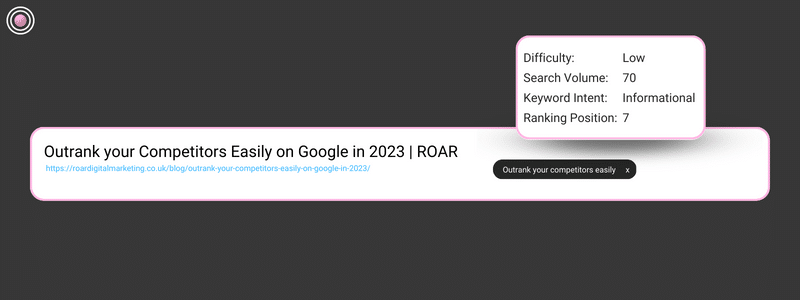
-
ROAR
- 6 Min Read
- Blog
How to Run an SEO Content Audit On My Website?
Time to review your website content? Take the time to understand which performing content and other SEO factors are providing value for your site and providing value for readers.
Why run an SEO Content Audit
An SEO Content audit finds the strengths and weaknesses of your content and opportunities to improve, as well as assesses all areas of SEO performance.
By running an SEO content audit, you can review and rework your content marketing strategy with a better understanding of the content which performs best and how people are receiving the content.
You’ll also be able to see quickly if you have outdated content or low-quality content that is having an adverse effect on your organic traffic.
Our team at ROAR is offering free SEO audits to businesses for a limited time: get yours here!
How to Run an SEO Content Audit
Depending on the size of your site, the SEO content audit process may feel like a massive overbearing task. Let’s break it down into manageable chunks to help you review your content performance and get optimising.
Set Goals
Before diving straight into assessing your SEO content audit, you need to decide what you deem as successful.
This can be based on how competitive your industry is. For businesses in competitive industries to have content ranking on page one may already be deemed a success. However, some businesses may see success as being in the top three search engine results for a given term.
What are you trying to achieve by auditing your content?
Knowing what you want will help you determine exactly what steps to take with underperforming content. It may be improving older content, removing redundant content, or improving SEO results for specific pages or the whole site.
Whatever you decide as categorically successful, you need to stick to it; otherwise, post-audit, your content will be just as mismatched.
Collect Content
Collecting content should be relatively simple if you have a solid SEO content management system set up. If you don’t, fear not – but here’s why you need it “Why you need SEO Content Management“
Create a list of URLs for the content you want to audit, and mark down the title and type of content it is. However, if your website is bigger than just a few pages, you’ll need a way to organise it to make it a much more manageable process for you or your team. We’d recommend a Google Sheet or Excel spreadsheet so you can clearly determine each piece of content almost like a content inventory.
Review Content
When assessing the SEO value of your content right now, you need to consider plenty of factors and there are plenty of SEO tools that can support this step. The number one tool that every business should be using is Google Analytics.
How long has the content been published?
Google takes its time ranking content and, in some cases, can take up to six months to really decide the value of the content. So, if the content has been published for less than 6 months, leave it be, and you can always come back to it next time.
Is your content ranking?
Search engine rankings are the clearest view of how content performs. What you’re looking for at this point is if your content ranks within the range you’re deeming successful.
If yes, you can leave it to continue, if not, lets look further into it and see the potential opportunities to improve.
Does it have a targeted and relevant keyword?
For older articles, keywords may be too broad or, in some cases, too niche. Take the time to review the article and do some keyword research around it to find a more relevant keyword where you need it.
Does that keyword have any search volume around it?
Keyword volume and stats always change based on what people are actually looking for. It may be worth seeing if your keyword still has volume and traffic around it, and if not, doing some keyword research and finding another relevant keyword with volume around it.
You can use Google Trends to see the volume around your keywords individually, or if you’re a user of ROAR’s DIY SEO Platform, you can use your Keyword Sitemap to see the page, the keyword, the volume and your ranking all in one place.
Through this link, you can get a 7-day free trial of ROAR’s DIY SEO Platform to improve your organic rankings and develop your SEO knowledge today!
How difficult is your keyword?
As much as a keyword with a volume of 16,000 is a nice site to see if the difficulty is 40 or higher, it’s pretty clear that ranking for that keyword with the support of one blog will not be possible. So if you review an old keyword and the volume is marked as 70 and it’s the only blog of that cluster, it’s a definite sign that you need to look into a new keyword.
Are people reading your content?
Through analytics tools like Google Analytics, you can see your bounce rate; this determines the number of people who land on your page and then leave without taking any further action.
Bounce rate won’t directly affect how your page ranks, but it does give an overview as to how actual people are interacting with your content. The average bounce rate for organic search content is 43.60%, but they can vary drastically.
If you haven’t quite mastered website analytics yet check out our list of the best SEO analytics tools
Which content type performs best?
Often, there may be a type of content that perform best for a site; however, it can also depend on the keyword. To check the keyword, jump into an incognito tab and search for it. If there is a pattern within the search results, this may be infographics, listicle articles, or long-form articles.
This will make it clear pretty quickly why that type of content has or hasn’t performed well for that term.
Have you included internal links to other content?
The content on your website should be linked to each other to give users a clear guide of where else they could be going on your site. Our top tip would be to include at least one internal link for each blog you write.
Check out our guide on internal linking for SEO to understand the importance and best practices
Adjust content accordingly
And you’ve done it! An SEO audit for all of your relevant content, but what next?
At this stage, you have some decisions to make; you could choose to do nothing and leave all of your content exactly the way it is. Making the whole exercise of the SEO content audit pointless… or we could make some changes.
Keyword Research
For content without a relevant keyword or no search volume. Perform some keyword research to pick out a relevant and high-qualtiy focus keyword.
Once you’ve selected a new keyword you’ll need to reoptimise your content. Some key things to remember to include are:
- Include the target keyword in the H1 and intro
- Include the keyword throughout the content
- Add the keyword to the meta description and title.
When it comes to adding your keyword into the content ensure you don’t end up keyword stuffing. Our top tip to avoid this is to only add the keyword into the copy where it would fit within conversation. If you force it into the content it won’t read well and users will notice.
Check out our YouTube Video – Optimising your content for SEO, to make sure you’re optimising your content to the best of your ability.
Merge content
If you’re finding that a lot of content gaps and room for improvement or re-optimisation, you may choose to merge the content into one big guide or blog.
This can help your content strategy to target broader and more competitive terms and help boost your business’s authoritative voice in the industry.
Delete or leave?
If a piece of content isn’t ranking within the top 20, but the ranking for that keyword isn’t crucial, you can leave it as it is or even delete it.
When deleting content, ensure to take into consideration internal and external links that lead to the page. Without checking and amending these links you’ll be left with broken links when you delete the content and this comes across poorly to both users and search engine crawlers.
Successful Content
As time goes on, make sure to keep an eye on ranking and if content begins to drop, boost and add to it to keep it up-to-date and relevant. However, if you’re pleased with how your content is performing, you can relax and take a breather – you can’t fix something that isn’t broken. If you’ve created content that ranks and remains high quality and relevant for users at any specific time, this may be viewed as evergreen content.
Our Final Thoughts
To recap –
- An SEO content Audit sounds scarier than it is
- Every business with a website should be using Google Analytics
- Keyword selection plays such a big part in content success
- Give your content time to be crawled, indexed and ranked effectively
- If you rank for a specific content asset see if it works for similar keywords too
- Deleting content can effect your internal linking structure so review that first
- Evergreen content pieces of content will support your business for a long time
- Improved content will boost your organic traffic and other metrics visible in Google Analytics
Speak to our team of SEO specialists today for more on our SEO Management Services and Consultancy.






